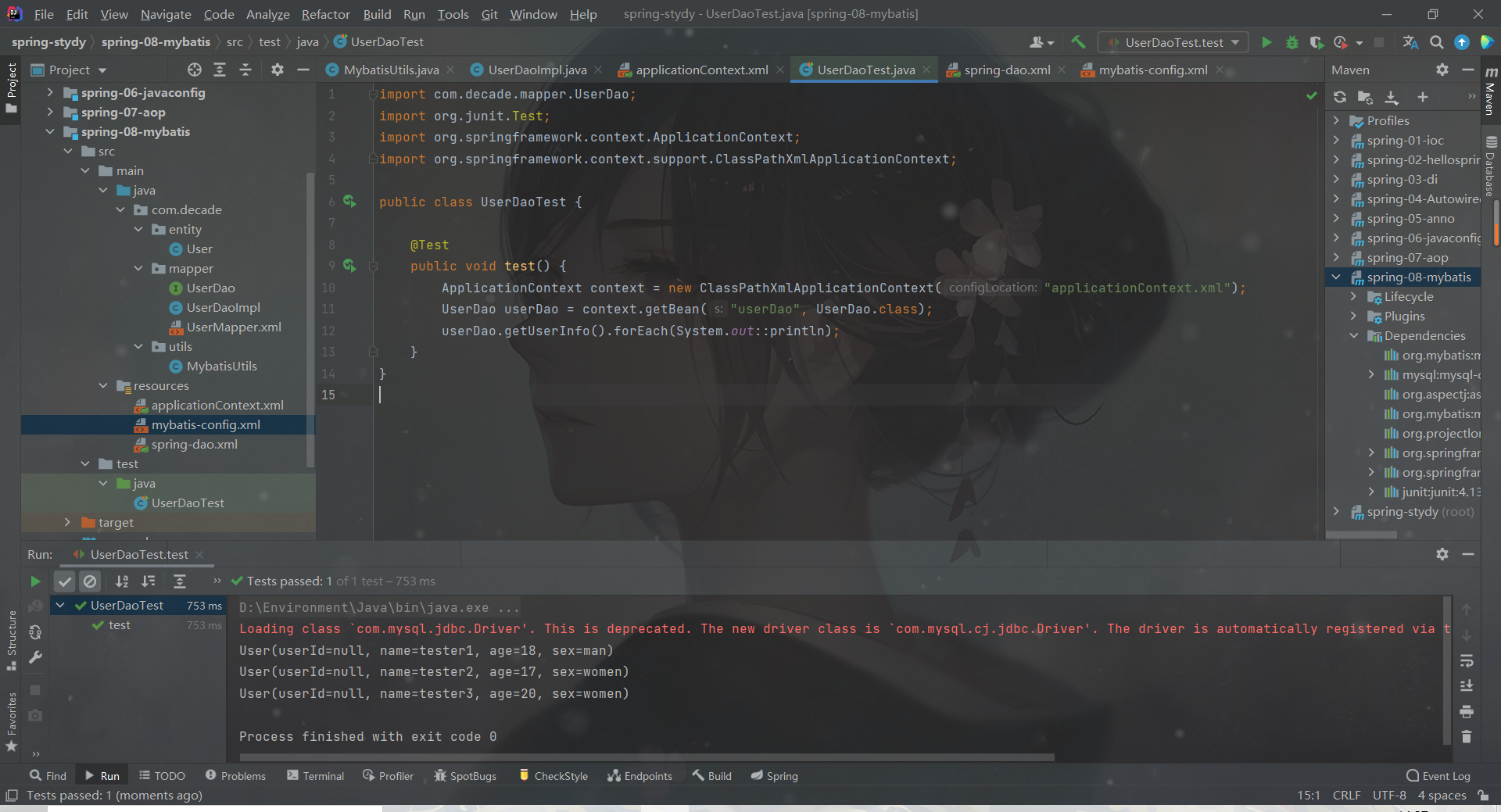1, Gossip
The weekend is coming again. Today, finish the spring blog, and then start the review of mybatis. I read it in July last year. If I don't write a blog, I'll soon forget it. Ha ha
2, Review mybatis and introduce integration methods
1. mybatis review
mybatis has written a simple example before. You can take a look at the previous blog
Introduction to Mybatis and construction of the first simple demo
2. Integration method 1: use SqlSessionTemplate in mybatis spring
Can refer to Official document of mybatis spring
First, we import the related dependencies into the pom file
<dependencies>
<!--MySQL drive-->
<dependency>
<groupId>org.mybatis</groupId>
<artifactId>mybatis</artifactId>
<version>3.5.6</version>
</dependency>
<!--Mybatis-->
<dependency>
<groupId>mysql</groupId>
<artifactId>mysql-connector-java</artifactId>
<version>8.0.27</version>
</dependency>
<dependency>
<groupId>org.aspectj</groupId>
<artifactId>aspectjweaver</artifactId>
<version>1.9.8</version>
</dependency>
<dependency>
<groupId>org.mybatis</groupId>
<artifactId>mybatis-spring</artifactId>
<version>2.0.6</version>
</dependency>
<dependency>
<groupId>org.projectlombok</groupId>
<artifactId>lombok</artifactId>
<version>1.18.8</version>
</dependency>
</dependencies>
In the original mybatis configuration file, we only put alias configuration. Of course, this configuration file can be completely omitted. All relevant configurations can be put into the spring configuration file
<?xml version="1.0" encoding="UTF-8" ?>
<!DOCTYPE configuration
PUBLIC "-//mybatis.org//DTD Config 3.0//EN"
"http://mybatis.org/dtd/mybatis-3-config.dtd">
<configuration>
<typeAliases>
<package name="com.decade.entity"/>
</typeAliases>
</configuration>
Next, let's configure the relevant configuration files of spring management data source
Create a spring Dao XML to manage database connection information
<?xml version="1.0" encoding="UTF-8"?>
<beans xmlns="http://www.springframework.org/schema/beans"
xmlns:xsi="http://www.w3.org/2001/XMLSchema-instance"
xsi:schemaLocation="http://www.springframework.org/schema/beans
https://www.springframework.org/schema/beans/spring-beans.xsd">
<!-- Configure data source, using spring Data source replacement for mybatis, c3p0 druid dbcp -->
<bean id="dataSource" class="org.springframework.jdbc.datasource.DriverManagerDataSource">
<!--Drive configuration, com.mysql.jdbc.driver -->
<property name="driverClassName" value="com.mysql.jdbc.Driver"/>
<property name="url" value="jdbc:mysql://localhost:3306/decade_test?useUnicode=true&characterEncoding=UTF-8"/>
<property name="username" value="root"/>
<property name="password" value="root"/>
</bean>
<!-- establish sqlSessionFactory -->
<bean id="sqlSessionFactory" class="org.mybatis.spring.SqlSessionFactoryBean">
<property name="dataSource" ref="dataSource"/>
<!-- binding mybatis Configuration file for -->
<property name="configLocation" value="classpath:mybatis-config.xml"/>
<property name="mapperLocations" value="classpath:com/decade/mapper/*.xml"/>
</bean>
<!--establish sqlSessionTemplate,Replace the original sqlSession -->
<bean id="sqlSessionTemplate" class="org.mybatis.spring.SqlSessionTemplate">
<!--because sqlSessionTemplate No, set Method, so we use constructor injection -->
<constructor-arg index="0" ref="sqlSessionFactory"/>
</bean>
</beans>
Note: if you want to configure the SqlSessionTemplate instance through annotation, you can refer to this section
@Configuration
public class MyBatisConfig {
@Bean
public SqlSessionTemplate sqlSession() throws Exception {
return new SqlSessionTemplate(sqlSessionFactory());
}
}
Then there is the general configuration file ApplicationContext XML, we just need to import the above configuration file
<?xml version="1.0" encoding="UTF-8"?>
<beans xmlns="http://www.springframework.org/schema/beans"
xmlns:xsi="http://www.w3.org/2001/XMLSchema-instance"
xsi:schemaLocation="http://www.springframework.org/schema/beans
https://www.springframework.org/schema/beans/spring-beans.xsd">
<import resource="spring-dao.xml"/>
<bean id="userDao" class="com.decade.mapper.UserDaoImpl">
<property name="sqlSessionTemplate" ref="sqlSessionTemplate"/>
</bean>
</beans>
Different from mybatis, we need to add an implementation class of UserDao to obtain sqlSessionTemplate as a business class
package com.decade.mapper;
import com.decade.entity.User;
import org.mybatis.spring.SqlSessionTemplate;
import java.util.List;
public class UserDaoImpl implements UserDao{
// The sqlSessionTemplate here replaces the original sqlSession
private SqlSessionTemplate sqlSessionTemplate;
public void setSqlSessionTemplate(SqlSessionTemplate sqlSessionTemplate) {
this.sqlSessionTemplate = sqlSessionTemplate;
}
@Override
public List<User> getUserInfo() {
UserDao mapper = sqlSessionTemplate.getMapper(UserDao.class);
return mapper.getUserInfo();
}
}
Finally, we create a new test class. We only need to get the bean of UserDao's implementation class from the spring context
import com.decade.mapper.UserDao;
import org.junit.Test;
import org.springframework.context.ApplicationContext;
import org.springframework.context.support.ClassPathXmlApplicationContext;
public class UserDaoTest {
@Test
public void test() {
ApplicationContext context = new ClassPathXmlApplicationContext("applicationContext.xml");
UserDao userDao = context.getBean("userDao", UserDao.class);
userDao.getUserInfo().forEach(System.out::println);
}
}
The operation results are as follows

3. Integration method 2: use SqlSessionDaoSupport in mybatis spring
Mode 2 is simpler than mode 1
It does not need to be injected through the set method, but only needs to inherit an abstract SqlSessionDaoSupport class
package com.decade.mapper;
import com.decade.entity.User;
import org.mybatis.spring.support.SqlSessionDaoSupport;
import java.util.List;
public class UserDaoImpl2 extends SqlSessionDaoSupport implements UserDao {
@Override
public List<User> getUserInfo() {
return getSqlSession().getMapper(UserDao.class).getUserInfo();
}
}
Use spring Dao in this way The sqlsession in the XML configuration file does not need to be configured
applicationContext.xml is configured as follows
<?xml version="1.0" encoding="UTF-8"?>
<beans xmlns="http://www.springframework.org/schema/beans"
xmlns:xsi="http://www.w3.org/2001/XMLSchema-instance"
xsi:schemaLocation="http://www.springframework.org/schema/beans
https://www.springframework.org/schema/beans/spring-beans.xsd">
<import resource="spring-dao.xml"/>
<bean id="userDao2" class="com.decade.mapper.UserDaoImpl2">
<property name="sqlSessionFactory" ref="sqlSessionFactory"/>
</bean>
</beans>
Write test class
import com.decade.mapper.UserDao;
import org.junit.Test;
import org.springframework.context.ApplicationContext;
import org.springframework.context.support.ClassPathXmlApplicationContext;
public class UserDaoTest {
@Test
public void test() {
ApplicationContext context = new ClassPathXmlApplicationContext("applicationContext.xml");
UserDao userDao = context.getBean("userDao2", UserDao.class);
userDao.getUserInfo().forEach(System.out::println);
}
}
Run the test class and the result is the same as that in mode 1
If there is any mistake, please correct it